Raccoons are known for their intelligence and adaptability, traits that lead them straight to the alluring confines of our backyard chicken coops. These nocturnal marauders pose a serious threat to the safety of our feathered friends and the integrity of our property.

Understanding how to keep raccoons away from chickens is crucial for all poultry enthusiasts. In this comprehensive guide, we delve into an array of protective strategies that cater to diverse coop configurations and security preferences, ensuring your chickens remain safe from these cunning intruders.
Understanding the Enemy: Raccoon Behavior and Weaknesses
Knowing your adversary is the first step in fortification. Raccoons, by nature nocturnal creatures, are most active at night and during the twilight hours of dusk and dawn. This is when they are on a persistent quest for sustenance, which often leads them to the abundance a chicken coop provides.
They are proficient climbers and remarkable problem solvers, adept at identifying and exploiting the weakest links in a coop’s defenses to gain easy entry. Although voracious in their appetite for chicken feed, eggs, and leftover scraps, raccoons are intrinsically cautious and timid creatures.
They have a natural aversion to loud noises, bright, unexpected lights, and unfamiliar, potent scents—all weaknesses that can be strategized against in our defense plans. Grasping their behaviors and vulnerabilities allows us to tailor effective deterrents and secure our chickens against these clever and opportunistic raiders.
How to Keep Raccoons Away from Chickens: Protecting Your Chickens
1. Fortifying Your Coop: The First Line of Defense
The core of any effective strategy to keep raccoons away from chickens starts with a stout defense: the coop itself. To thwart these nimble marauders, begin with robust materials. Employ sturdy wire mesh, commonly known as hardware cloth, selecting varieties with openings no larger than 1/2 inch to prevent any reach-ins or break-ins. Ensure that every joint, edge, and corner where the wire meets the wood is securely fastened, leaving no leeway for raccoons to apply their nimble paws and pry open a passage.
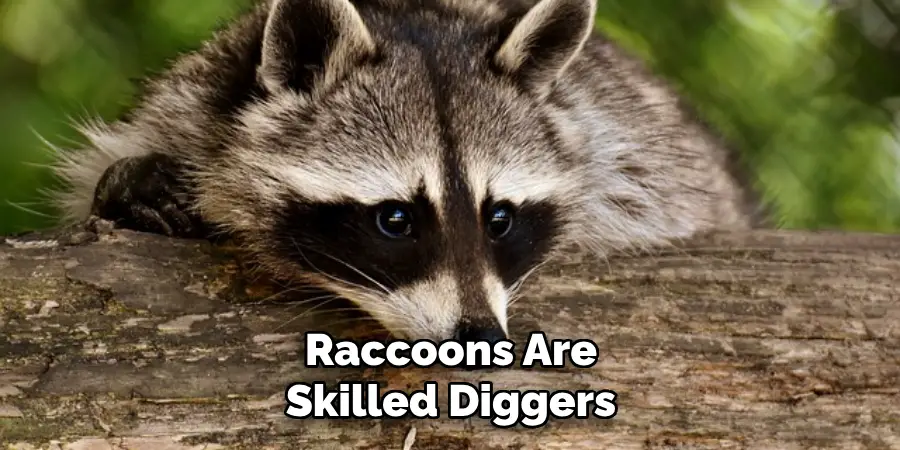
Equally imperative is a robust roof and floor system. Raccoons are skilled diggers, capable of tunneling their way beneath fences and into your coop. Extend the hardware cloth at least 2 feet below the ground around the coop’s perimeter to halt these efforts and lay it underneath the coop’s flooring. Coupled with this, a reinforced roof will ensure that entry from above is also guarded against.
Next, turn your attention to the closure mechanisms. Opt for high-quality locks and latches for all coop doors and entry points—ones that defy dexterous raccoon fingers and require human intelligence. Spring-loaded locks or combination latches can offer an additional layer of complexity that discourages even the most persistent invaders.
Finally, it eliminates advantageous terrain for the stealthy creatures. Clear away brush, branches, and structures that may serve as ladders or camouflage for the prowling raccoons. Any cover that provides them a staging ground for attack should be removed. Additionally, consider installing predator-proof doors designed specifically to withstand the strength and ingenuity of determined predators, adding an extra level of security to the coop’s fortifications.
2. Deterrence Tactics: Keeping Raccoons at Bay
To discourage raccoons from setting their sights on your chicken coop, a diverse arsenal of deterrence tactics can be highly effective. Initiating a surprise factor, motion-activated lights cast an abrupt glare in the darkness, unsettling these skittish nocturnal creatures. Similarly, motion-activated sprinklers release sudden sprays of water, creating an unwelcome environment for any raccoon attempting to infiltrate coop boundaries.
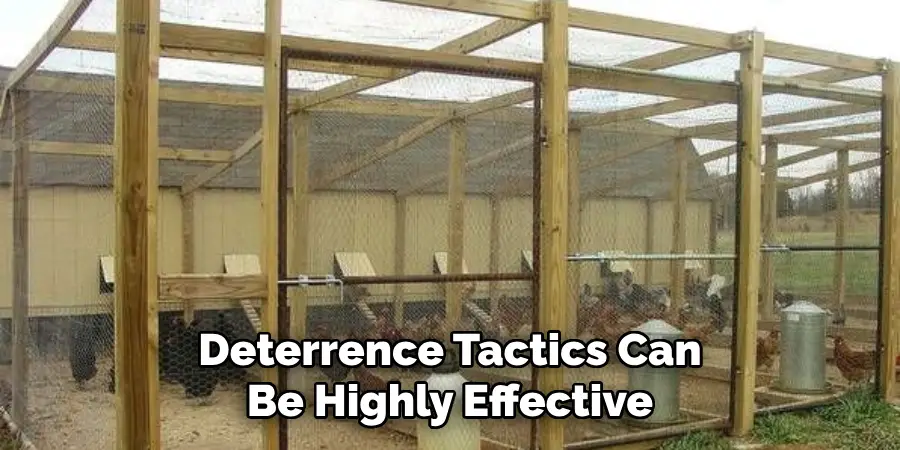
An unconventional yet potent deterrent involves the use of predator urine. This method hinges on the raccoon’s survival instincts; the raccoons are likely to steer clear by perceiving the scent of a potential threat, like that of a coyote or fox. Be sure to follow the product’s instructions for application to ensure maximum efficacy.
A symphony of scare tactics can be enabled through loud noises. Devices that produce intermittent sounds mimicking predator calls or high-pitched alarms activated by motion sensors can disrupt a raccoon’s sense of security, influencing it to bypass your property in search of a more serene raiding ground.
Lastly, the employment of natural repellents offers an eco-friendly choice—substances such as cayenne pepper flakes, diluted hot pepper spray, or specific essential oils associated with predators (after confirming their safety and effectiveness) can deter raccoons without harming the environment.
For continued success, it’s paramount to rotate these deterrents regularly. Habituation renders any method less effective over time, so keep raccoons guessing and maintain the element of unpredictability to protect your flock.
Additional Security Measures and Management Practices
Along with fortifying the coop and employing various deterrence tactics, additional security measures and proactive management practices are paramount in safeguarding your chickens from raccoon predation. Key practices include:
- Frequent Egg Collection: Leftover eggs are a raccoon’s delight. Make it a habit to collect eggs often, ideally before dusk, to remove this temptation.

- Secure Feed and Water Storage: Raccoons are attracted to easily accessible food and water. Ensure feed and water containers are stored inside a secure area, such as a locked shed or robust coop annex, at night or when not in use.
- Minimized Food Scraps: Efficiently manage your chickens’ food to minimize spillage. Clean up any feed and debris scattered around the coop to deter raccoons drawn by leftover scraps.
- Guardian Animals: Though not a solution for everyone, guardian animals such as dogs, llamas, or geese, when properly trained and cared for, can be effective deterrents against raccoon incursions.
- Consistent Inspections: Regular coop inspections help identify and promptly repair any weak spots or potential entry points, thwarting raccoon ingenuity.
- Stay Informed: Understanding local raccoon behavior patterns and keeping abreast of regional wildlife regulations can inform and enhance your predator control strategies.
By systematically incorporating these practices, poultry enthusiasts can cultivate an environment that is less inviting to raccoons and more secure for their cherished chickens.
Addressing Specific Raccoon Challenges
Addressing the nuanced challenges raccoons present requires a multi-faceted approach. Combine several deterrent methods such as lighting, noises, and natural repellents for persistent or determined raccoons who seem undeterred by initial measures. If these clever invaders continue to breach your defenses, it may be time to seek professional wildlife removal services to mitigate the issue safely and ethically.
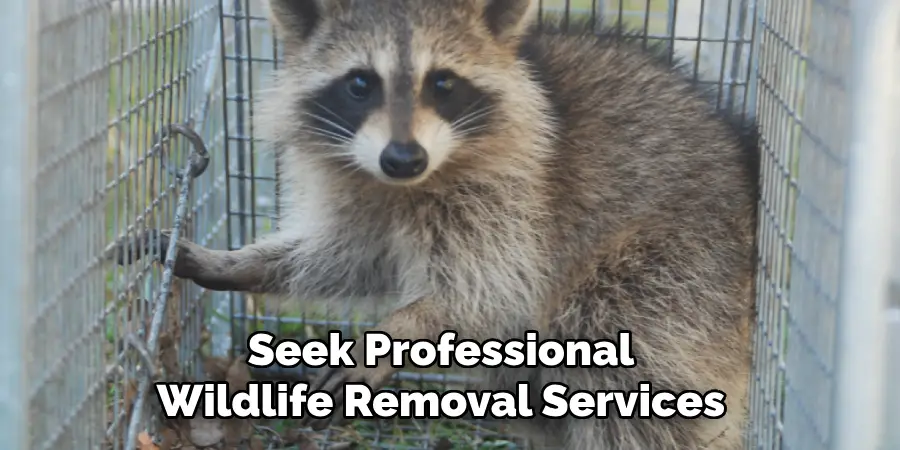
Should your coop sustain damage from a raccoon’s adventure, act swiftly to mend the breaches. Utilize robust materials like hardware cloth or solid wood panels to replace or reinforce the affected areas. Thorough evaluations post-repair are crucial to unearth any structural weaknesses that raccoons might exploit again.
In cases where raccoons become trapped within your coop or property, resist the urge to intervene directly. Instead, contact local animal control professionals to handle the safe removal of these wild animals. This protects you from potential harm and ensures the raccoon is dealt with humanely.
Those concerned about inadvertently harming non-target animals during their protection efforts should prioritize humane deterrent options. Motion-activated lights and sprinklers are effective without causing injury. It is imperative to shun the use of poisons or lethal traps that pose risks to all local wildlife and domestic pets, maintaining a safe ecosystem for all inhabitants.
Going the Extra Mile: Advanced Deterrence Techniques
For those facing highly persistent raccoons, advanced deterrence techniques may be required. One such measure is the installation of electric fencing around the perimeter of the coop. Installing a properly grounded system that complies with safety guidelines and local regulations is vital. Electric fencing delivers a brief, safe shock that deters raccoons without causing long-term harm.
Another method involves utilizing live traps to humanely capture and relocate raccoons. However, this method requires adherence to wildlife management laws: securing the necessary permits and ensuring that the relocation of the animal complies with local regulations. Live trapping should be seen as a last resort and done in a manner that prioritizes the raccoon’s welfare.

Ultrasonic devices can also serve as an advanced deterrent, emitting frequencies that are uncomfortable for raccoons but inaudible to humans. It is important to choose devices with varying frequencies to prevent raccoons from becoming habituated, and researching their effectiveness and potential impacts on other animals is advised.
Lastly, placing ammonia-soaked rags near potential entry points may discourage raccoon attempts to enter the coop area. The strong odor simulates the presence of a predator’s urine. However, take caution as the odor is pungent and may be harmful if pets or children come into contact with it. Use this method judiciously and ensure it poses no threat to your household or the environment.
Technology to the Rescue: Smart Coop Security
In the digital age, emerging technologies are revolutionizing chicken coop security. Remote monitoring systems are at the forefront, employing cameras and sensors that allow poultry keepers to oversee coop activity from afar via their smartphones. These systems alert owners to unusual movements, enabling rapid response to potential intruders.
Smart locks bring another layer of protection by allowing remote control of coop doors, preventing unwanted access after dusk or when away from home. Additionally, automated deterrents can be activated from anywhere, dispersing predators by triggering lights or sounds upon detection of movement.
These technological advancements provide great convenience and reinforce security measures but should be considered supplementary tools. They’re not substitutes for rigorous coop construction or regular, hands-on inspection and management practices essential for the long-term safety of your feathered flock.
That’s it! You’ve now learned how to keep raccoons away from chickens and safeguard your poultry from these persistent predators. Remember to prioritize safety for yourself and the raccoons while staying informed on effective deterrent methods.
You can successfully coexist with wildlife in your backyard with diligence and smart management practices. So go ahead and start planning your predator-resistant coop today!
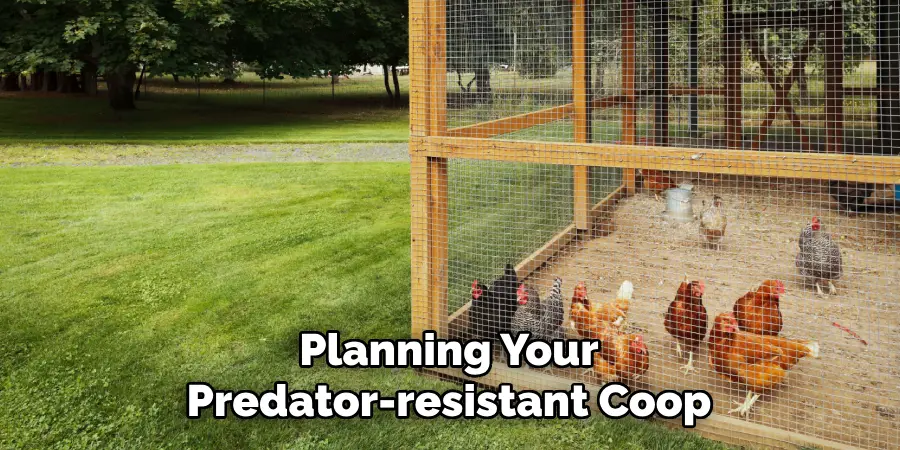
Finding Harmony with Nature: Peaceful Coexistence Tips
Achieving a balance with the wildlife sharing our environments requires mindful cohabitation practices. Responsible wildlife management is pivotal, focusing on reducing attractants: ensure that secure bins are used to remove potential food sources from your property, not just near the chicken coop.
Offering alternative food sources, like setting up a wildlife feeder stocked with raccoon-friendly treats such as fruits or nuts, can keep them at bay from the coop. Appreciate raccoons’ role in the ecosystem – their knack for rodent control can be advantageous.
However, it’s vital to maintain a respectful distance, observe these nocturnal explorers from afar, and refrain from direct human interactions that could lead to habituation. We can foster a setting where humans and wildlife coexist in mutual respect and minimal conflict by embracing these measures.
Embracing Wildlife Stewardship
As stewards of our environment, we must practice wildlife management responsibly. Minimizing attractants plays a key role—securing garbage cans, compost bins, and pet food to thwart raccoon scavenging beyond the immediate surroundings of the chicken coop.
Consider introducing a wildlife feeder positioned at a safe distance from domestic areas and stock it with appropriate food, such as corn or special wildlife mixtures.
This serves the dual purpose of providing for raccoons and diverting them from the coop. Acknowledging raccoons’ contribution to the ecosystem is important, as they help control unwanted vermin. Yet, maintaining a cautious and respectful distance is crucial.
Delight in watching their antics from afar and resist the temptation to tame or interact with them. By implementing these practices, we not only protect our own interests but also honor the raccoons’ place in nature’s tapestry, enabling peaceful and sustainable coexistence.
5 Benefits of Keeping Raccoons Away from Chickens
For backyard poultry owners, the threat of raccoons can be as common as it is frustrating. Not only can these intelligent and nimble mammals wreak havoc on a peaceful coop, but they can also pose significant health risks. Here are five undeniable benefits of keeping raccoons at bay, ensuring your chickens remain safe, stress-free, and productive.
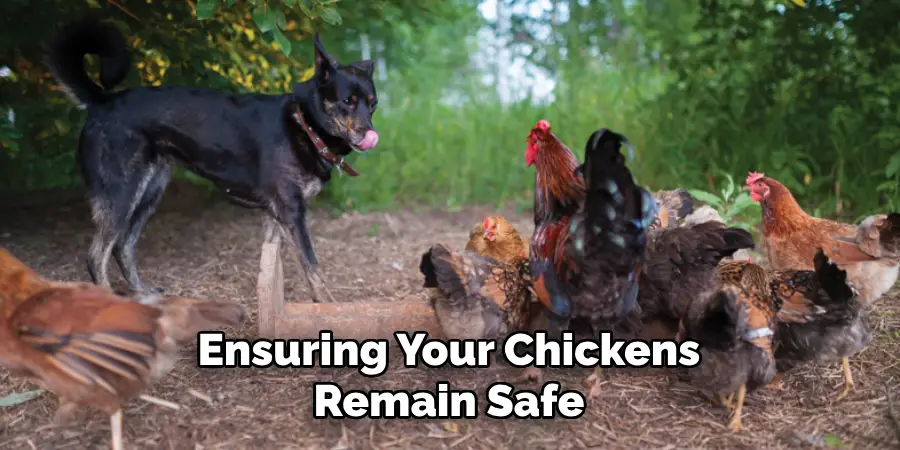
1. Prevention of Chicken Loss
Raccoons: Nighttime Predators in Disguise
- Raccoons are known for their predatory behavior, especially at night.
- Keeping them away can significantly reduce their threat, protecting your chicken population from potential attacks.
2. Disease Prevention
The Hidden Health Hazard in Tiny Paws
- Raccoons can carry a variety of diseases, including rabies and parasitic worms.
- By taking proactive measures to keep these critters away, you minimize health risks to your flock, ensuring that the chickens and those handling them stay healthier.
3. Stress Reduction for Chickens
A Serene Coop is a Happy Coop
- The mere presence of raccoons near a chicken coop can cause undue stress to your feathered friends.
- Raccoon-free zones help maintain a sense of safety for chickens, promoting natural behaviors and potentially improving laying rates.
4. Protection of Eggs
Say No to Furry Egg Heists
- Raccoons possess dexterous paws, which they can use to snatch eggs from the nest.
- Securing your coop against these sly creatures ensures that the hard work of your layers doesn’t end up as an easy snack for unwelcome guests and supports sustained egg production.
5. Peace of Mind for Poultry Owners
Sleep Soundly Knowing Your Flock is Safe
- The safety of your chickens is a direct reflection of your peace of mind.
- With anti-raccoon measures in place, you can sleep soundly, knowing that the likelihood of midnight marauders disturbing your flock is greatly diminished.
Protecting chickens from raccoon intrusions is essential for every responsible poultry owner. Implementing strategic deterrents and enhancing coop security can have long-lasting, positive effects on your birds’ quality of life and your experience as a guardian of backyard poultry. Share these benefits with fellow animal enthusiasts, and let’s keep our feathered friends safe!
Frequently Asked Questions
How Can I Make My Chicken Coop Raccoon-Proof?
A: Enhance your coop’s security with robust hardware cloth instead of chicken wire, secure lids or doors with locking mechanisms, and consider installing motion-sensor lighting or automatic coop doors that close at dusk. Regular inspections for vulnerabilities can also prevent raccoon access.
Are Raccoons the Only Predators I Should Worry About?
A: Absolutely. While raccoons are common threats, other predators such as foxes, hawks, coyotes, and even neighborhood dogs can pose risks. The best approach is to implement comprehensive security measures that address multiple types of predators.
How Do Raccoons Affect Chicken Behavior and Health?
A: Yes, raccoons can cause chickens to become stressed, leading to reduced egg production and possible health issues. The presence of raccoons also increases the risk of disease transmission to your flock.
Can I Use Traps to Catch Raccoons Around My Coop?
A: While trapping raccoons is a method some might consider, it is important to check local wildlife regulations, as it may be illegal in some areas. Additionally, professionals should handle trapped animals humanely to prevent injury and disease transmission.
What Should I Do if I See a Raccoon Near My Chicken Coop?
A: Ensure that your chickens are secure and assess the coop for any breaches. Deterring the raccoon with loud noises or bright lights may help in the short term, but you’ll need to implement long-term deterrents and possibly seek assistance from wildlife control specialists.
Conclusion: Essential Strategies for Raccoon Deterrence
In summary, understanding how to keep raccoons away from chickens is pivotal for any poultry keeper who desires to maintain a thriving and secure backyard flock. Emphasizing preventive tactics, sturdy coop defenses, and mindful wildlife stewardship can substantially mitigate these clever creatures’ risks. Remember, the goal is not to harm or eliminate raccoons but to effectively deter their access to your chickens.
We’ve explored various strategies and answered common questions, empowering you with the knowledge to protect your poultry investment. Stay vigilant and be proactive; your chickens will thank you for providing them with a safe haven against nocturnal threats. With these tips, your coop should remain a raccoon-free sanctuary where chickens can roost and owners can relax.
About
Outdoor Fixes is a distinguished figure in the world of Diy design, with a decade of expertise creating innovative and sustainable Diy solutions.
His professional focus lies in merging traditional craftsmanship with modern manufacturing techniques,
fostering designs that are both practical and environmentally conscious. As the author of diy,
outdoorfixes delves into the art and science of outdoorfixes-making, inspiring artisans and industry professionals alike.
Education RMIT University
(Melbourne, Australia) Associate Degree in Design (Outdoor Fixes) Focus on sustainable design, industry-driven projects,
and practical craftsmanship. Gained hands-on experience with traditional and digital manufacturing tools, such as CAD and CNC software.
Nottingham Trent University
(United Kingdom) Bachelor’s in outdoorfixes.com and Product Design (Honors) Specialized in product design with a focus on blending creativity with production
techniques. Participated in industry projects, working with companies like John Lewis and Vitsoe to gain real-world insights.
Publications and Impact
In diy, Outdoor Fixes his insights on indoor design processes, materials, and strategies for efficient production.
His writing bridges the gap between artisan knowledge and modern industry needs, making it a must-read for both budding designers and seasoned professionals.

